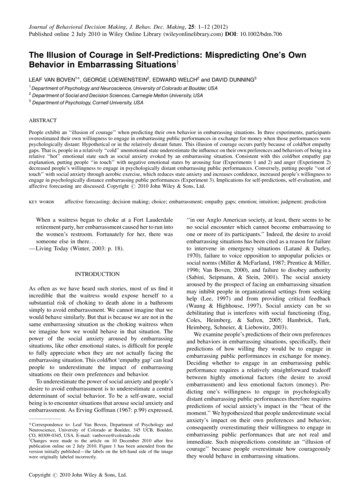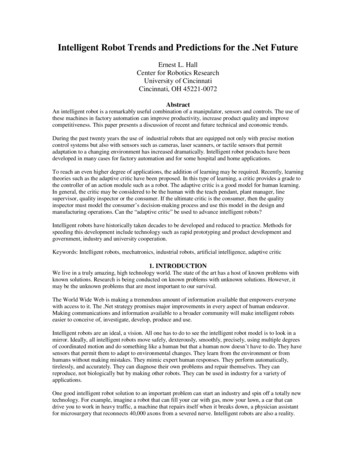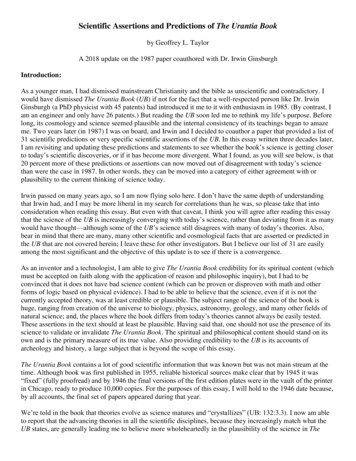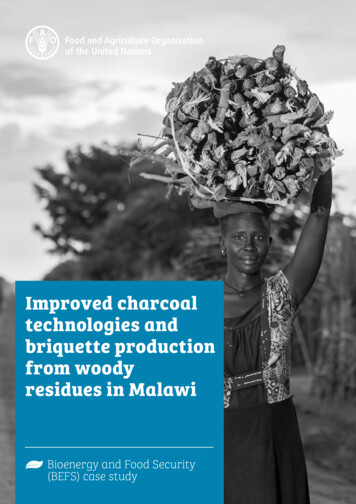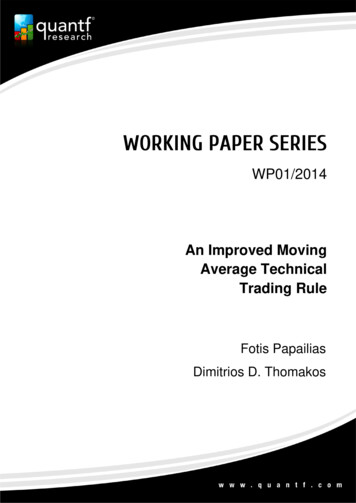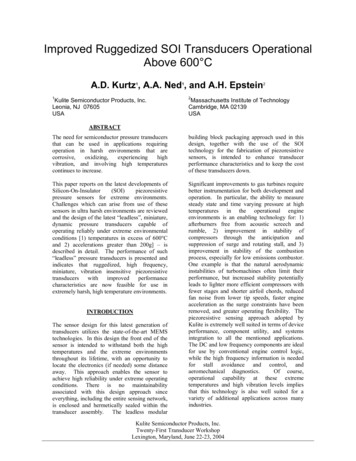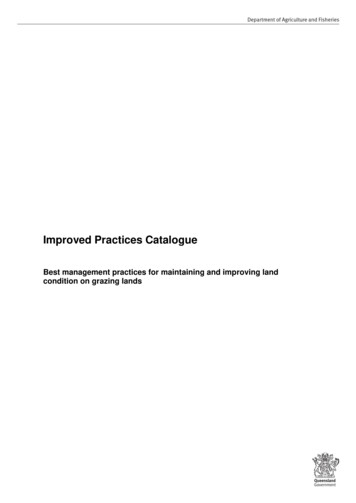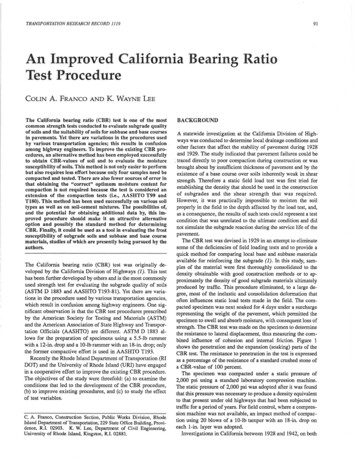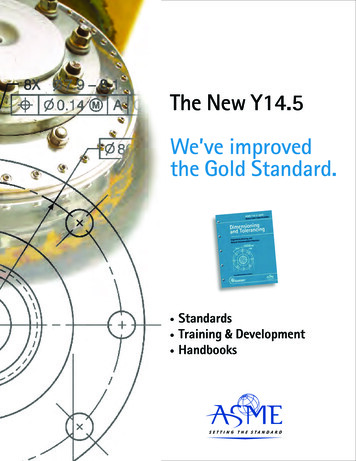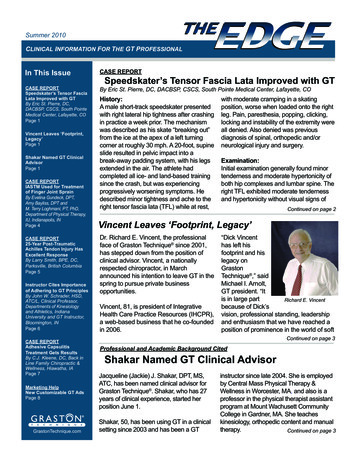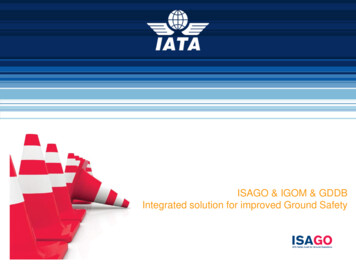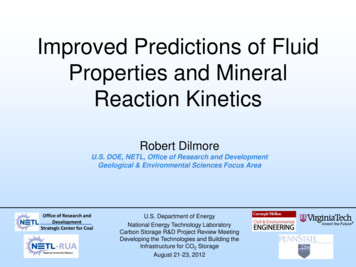
Transcription
Improved Predictions of FluidProperties and MineralReaction KineticsRobert DilmoreU.S. DOE, NETL, Office of Research and DevelopmentGeological & Environmental Sciences Focus AreaOffice of Research andDevelopmentStrategic Center for CoalU.S. Department of EnergyNational Energy Technology LaboratoryCarbon Storage R&D Project Review MeetingDeveloping the Technologies and Building theInfrastructure for CO2 StorageAugust 21-23, 2012
Improved Prediction of Fluid Properties andMineral Reaction Kinetics (Geochemical Impacts) International Round Robin comparison of geochemical gas-fluidrock reactions at elevated pressure-temperature (P-T) conditions– Team Members: Craig Griffith, NETL; Robert Dilmore, NETL; AngelaGoodman (PI), NETL; Sheila Hedges, NETL; Athanasios Karamalidis,CMU, and 13 International Participants Sensitivity analysis of mineral solution rates in reactive transport– Team Members: Victor Balashov, PSU; Sue Brantley (PI), PSU;George Guthrie, NETL; Ale Hakala, NETL; Christina Lopano, NETL Fluid Equilibria in scCO2-brine systems– Team Members: Haining Zhao, PSU; Derek Hall, PSU; AlexanderMorse, PSU; Mark Fedkin, PSU; Serguei Lvov (PI), PSU; RobertDilmore, NETL Multi-Model Predictive System for CO2 Solubility in Saline Waters– Team Members: Zan Wang, CMU; Mitchell J. Small, CMU;Athanasios K. Karamalidis (PI), CMU, Robert. Dilmore, NETL
International Round Robin comparison of geochemical gasfluid-rock reactions at elevated (P-T) conditions Organized and led by the Federal Institute forGeosciences and Natural Resources (BGR),Hannover, Germany and the USGS, Menlo Park,CA, USA.Project Objectives To compare the results of potential geochemicalchanges to water chemistry and sedimentarymineral composition over various experimentaltechniques conducted by several researchinstitutions. Assess uncertainty associated with geochemicalexperiments in gas-fluid-mineral systems.Programmatic Goal Addressed Understand the impacts of CO2 on mineralization ratesin different formation types to improve CCS operationsand storage integrityInvited ParticipantsUSGS (Menlo Park, US)BGR (Hannover, DE)GFZ (Potsdam, DE)RWTH Aachen (Aachen, DE)MLU Halle (Halle, DE)IFM-Geomar (Kiel, DE)BRGM/IFP (Orléans, FR)CNRS (Nancy, FR)LMTG (Toulouse, FR)BGS (Keyworth, GB)University of Leeds (Leeds, GB)U. Cambridge (Cambridge, GB)ETHZ (Zürich, CH)SINTEF (Trondheim, NO)IRIS (Stavanger, NO)TNO (Utrecht, NL)LBNL (Berkeley, US)U. Wyoming (Laramie, US)DOE NETL (Pittsburgh, US)Washington University (St. Louis, US)ARC & RECS (Alberta,CA )CO2CRC (Canberra, AU)RITE (Kyoto, JP)
International Inter-lab Round Robin OverviewThe motivation for this study is threefold:1. to provide an estimate of potential variance in kinetic (or thermodynamic) dataderived from gas-fluid-mineral interaction experiments using differentexperimental approaches in a variety of labs.2. to validate kinetic data for three mineral dissolution reactions at relevant in situpressure and temperature conditions (siderite, labradorite, illite at p 200 bars,T 80 C, CO2-saturated 2 M NaCl-brine)3. to strengthen the collaboration among experimental labs around the world andto streamline experimental programs for gas-fluid-mineral reaction studies.IllitePlagioclaseSiderite
International Inter-lab Round Robin AccomplishmentsTarget ParametersAPressure200 barsTemperature80 CInitial brinecompositionBrine to mineralinitial mass ratioCO2150g NaCl/L H2OTimeSiderite 1 weekIllite 2 weeksLabradorite 3 weeksOne prior and one at the injection of CO2; 5 post CO2 injection at temperature andpressurepHDissolved ions (Ca, Mg, Fe, Mn, Si, Al, Cl, SO4)Dissolved inorganic carbon or total CO2SamplingConed titanium seatAnalytesTitanium tubingTarget Conditions20:1CO2 saturated brine and scCO2 in the headspaceTitanium capillary tubingFlat titanium seatBTitanium filterA) Cross section of Dickson-type, flexible gold-titanium reaction cell, B)gold-titanium reaction cell emphasizing titanium closure configuration.(Source: modification after Seyfried et al., 1979; Seyfried et al., 1987)
International Inter-lab Round Robin Accomplishments10CO2 injection80CO2 injectionABConcentration, mg/LConcentration, Reaction Time (h)400CO2 injection30C150200300250200150100CO2 tion Time (h)50100150200250Reaction Time (h)CO2 injection5.5CO2 injectionEF5.0Concentration, mg/L100Concentration, mg/L25025Concentration, mg/LConcentration, mg/L100D35012050Reaction Time (h)806040204.5Total concentration (mg/L) of Cl- measured fromSiderite reaction brine before and after CO2 saturationas a function of reaction time (h).4.03.53.02.52.0Fe0Si1.5050100150Reaction Time (h)200250050100150200250Reaction Time (h)Total concentration (mg/L) of different cations released from Siderite when reacted with or without CO2saturated brine as a function of reaction time (h) after CO2 injection. Cations of interest: A) Al, B) Mg, C) Ca,D) Mn, E) Fe, and F) Si.
International Inter-lab Round Robin AccomplishmentsIlliteSideriteXRD analysis of the three minerals prior(black line) and post (red line) reaction withCO2. No significant changes are apparent,except for illite where halite is identified(blue lines).
International Inter-lab Round RobinTechnical Status and Future Work Gas-fluid-mineral experiments completed (November 30, 2011)ACS Spring Meeting 2012, San Diego Geochemical reactions of Illite, Labradorite and Sideritewith CO2-saturated salt solution under geologic CO2 storage conditions AthanasiosKaramalidis1,2*, Craig Griffith2, Robert Dilmore2, Sheila Hedges2, Christian Ostertag-Henning3,Angela Goodman21Civiland Environmental Engineering, Carnegie Mellon University, Pittsburgh, PA 15213, United States,Division, National Energy Technology Laboratories, U.S. Department of Energy, Pittsburgh, PA 15236, United States, 3Federal Institute for Geosciences and Natural Resources (BGR), Hannover, Germany2 Geosciences Comparison of results with 13 labs near completionPublically Available Final International Report (September, 2012)– technical report will be available for download from the BGR website– joint publication in Applied Geochemistry on the comparison of thedifferent (anonymous) data setsContinue the collaboration in the GaMin'11 group . and start GaMin'13 endof 2012.– focus on the comparison of mixed-flow/flow-through derived dissolutionrates with data from batch type reactor experiments, work on twominerals (calcite & K-feldspar) and use two salinities (again 150g/l andthen seawater)
Sensitivity analysis of mineral solution rates in scCO2-brine-sandstone system CCUS requires the ability to predict thebehavior of geologic system over thenear and long termModels are needed to understandwhether CCUS will effectively storeCO2 to warrant economic investment,meet regulations, and convince thepublic that CCUS is safeReactive diffusion model to explorerates and extents of water-rockreactions driven by emplacement ofCO2Storage security depends on acombination of physical (structural andresidual CO2 trapping) andgeochemical (solubility and mineraltrapping)References: IPCC, 2005: IPCC Special Report on Carbon Dioxide Capture and Storage. Prepared by Working Group III of the Intergovernmental Panel on Climate Change[Metz, B., O. Davidson, H. C. de Coninck, M. Loos, and L. A. Meyer (eds.)]. Cambridge University Press, Cambridge, United Kingdom and New York, NY, USA, 442 pp. Benson, S.M., 2008. Multi-Phase Flow and Trapping of CO2 in Saline Aquifers. (Paper No. OTC 19244). Published in the Proceedings of 2008 Offshore TechnologyConference held in Houston, TX, USA, May 5–8, 2008
Sensitivity analysis of mineral solution rates Overview Overall Goal: Develop a model of a prototypical reservoir based onmineralogical features common to many CO2 storage targets (usingthe EHS2 local equilibrium code and MK76 reactive transport code).Determine the mineral precipitation and dissolution processes that areimportant to storage permanence at brine/aquifer/caprock interfaces.Vary kinetic rates in the model within the known range of uncertainty todetermine the most sensitive parameters over various timescales. Importance: Geochemical calculations used to predict performance ofCO2 utilization and storage systems These calculations rely on thermodynamic & kineticdatabases with inherent uncertainty Uncertainties in kinetic data generally are larger thanthermodynamic data– lab and field rates vary by factors of 105 (White & Brantley,2005)References: Balashov V.N., Khudyaev V.S. Numerical modeling of infiltration metasomatic zoning at local equilibrium: program EHS. // Experimental problems in geology. Moscow, Nauka, 1994, p. 456-479.White, A.F. and Brantley, S.L., 2003. The Effect of Time on the Weathering of Silicate Minerals: Why Do weathering Rates Differ in the Laboratory and Field? Chemical Geology, 202: 479-506.
Sensitivity analysis of mineral solution rates AccomplishmentsBaseline Case (Sandstone Reservoir) Comparison among models isdifficult (different reservoircharacteristics, model approaches,thermodynamic and kineticdatabases) Offers opportunity for systematiccomparisons between modelsGeophysical conditions: 2 km / 75oC /30 MPa / Porosity0.25 / 0-25,000 yearsGeochemical conditions: 6 mineral system to start Brine chemistry derived fromaverage oil-field brinecompositionsBaseline brine compositionT 75oCP 30 mPaAve. Brine(molality)pH-TheoreticalBrine (molality)7.81Cl3-2.1462.146Na 1.6201.712Ca2 0.2580.217K 0.0121.1 x 10-3Al3 -9.9 x 10-3SiO2-3.0 x 10-40.00409.5 x 10-5HCO3-Baseline sandstone mineralogyMineralCompositionVol 3ng 2(m-3)4.9x 108KAlSi3O813.500.1251.9x10-26.9x 1010Ca0.2Na0.8Al1.2Si2.8O86.000.1251.8x10-23.1 x1010CaCO33.750.5004.4x10-33 002.3 x1016KAl3Si3O10(OH)20.750.0012.12x1007.5 x1015--25.00---Geometric specific surface areaNumber of mineral grains per unit volume of a porous mediumFigures from Balashov et al. (2012) submitted
Sensitivity analysis of mineral solution rates AccomplishmentsReactive Transport Modeling (CO2 & Sandstone Reservoir):1-3 meters Numerical reactive transport code with reaction kinetics (MK76) Investigate effect of diffusive-reactive partitioning of CO2 across the interface within thebaseline sandstone between sup CO2 and brine Ran sensitivity tests to determine impacts of the use of different reaction rateconstantsFigures from Balashov et al. (2012) submitted
Sensitivity analysis of mineral solution rates AccomplishmentsSensitivity Analysis – Part 1: Important controlling minerals & reaction pathways“Standard” rate constant valuesOlg * 10Olg * 0.1Summary of mineral/fluid reactions due toCO2 invasion into sandstoneReactionProgess0 – 10years10 – 50years50 – 100years100 – 1000years1,000 –5,000 years 0.1Mc Cc Mc Ab Mc Kln Mc Ab Mc 0.1 – 0.9Olg Smct Olg Cc Ab Smct Olg Kln Smct Kln Ab 0.9Smct Cc Cc dissolution and precipitation5,000 –10,000 yearsIll Kln Mc Model developed and run at PSU
Sensitivity analysis of mineral solution rates AccomplishmentsSensitivity Analysis – Part 2: Impacts to overall CO2 storageEnvironmental Risk Profle: Injection Phase ---Post Operation ---Post ClosureResults (CO2 & Sandstone Reservoir): 30 years: CO2 mostly trapped in solution 200-1000 years: replacement of oligoclase withsmectite / trapping of some CO2 as calcite /significant trapping of CO2 as bicarbonate ion 4000 years: CO2 equilibrium is established– 97% of the maximum stored CO2 (34.5 kgCO2/m3 sandstone) is partitioned asfollows: oligoclasealbitesmectite70% solubility trapping30% mineral trapping (calcite)25,000 years: final mineral equilibriumestablished – quartz-illite-calcite-microclineVariations in reaction rates mostly affectstorage-reservoir behavior in the 10-1000 yeartime frame, and is dependent on kineticcouplingThe effect of changes in the rate constants foroligoclase, albite and smectite on the relative totalCO2 sequestered in the sandstone (sensitivity factor)plotted versus time.CO2 sequestration is sensitive to variability in the mineral rate constants ofoligoclase, albite, and smectite to varying degrees (ol al sm)Figures from Balashov et al. (2012) submitted
Sensitivity analysis of mineral solution ratesOn-going & Future Work (FY 2012 ) Overall Goal: Determine the mineral precipitationand dissolution processes that are important tostorage permanence at brine/aquifer/caprockinterfaces. Vary kinetic rates in the model within theknown range of uncertainty to determine the mostsensitive parameters over different time frames– Key focus: Caprock (particularly shale) Develop baseline shale model inputs Include Fe-rich phases such as pyrite (FeS2) Sensitivity analyses – pinpoint key mineral/brineconstituents where variability affects predictivesequestration models Relate modeling results to experimental efforts(compare/contrast mineraldissolution/precipitation)Baseline shale mineralogyMineralCompositionMass 3Si3O10(OH)240Al2Si2O5(OH)4 tzCalciteSmectiteIlliteKaolinitePyrite– e.g. Isotope tracers, trace metal transport Complete September, 2012– Future: Expand work to make links to flowregimesComplete sensitivity analysis for mineral kinetics for CO2- saturated brine/aquifer/caprockinterface
Sensitivity analysis of mineral solution rates Time LineOverall Scope and Time Line: Reactive transport modeling and kinetic sensitivity study ofCO2-storage in a sandstone reservoir is complete Manuscript submitted to Applied Geochemistry – Jan. 2012Balashov, V.N., Guthrie, G.D., Hakala, J.A., Lopano, C.L., Rimstidt, J.D., and Brantley S.L. “Predictive Mo
changes to water chemistry and sedimentary mineral composition over various experimental techniques conducted by several research institutions. Assess uncertainty associated with geochemical experiments in gas-fluid-mineral systems. Programmatic Goal Addressed Understand the impacts of CO 2 on mineralization rates in different formation types to improve CCS operations and storage .

